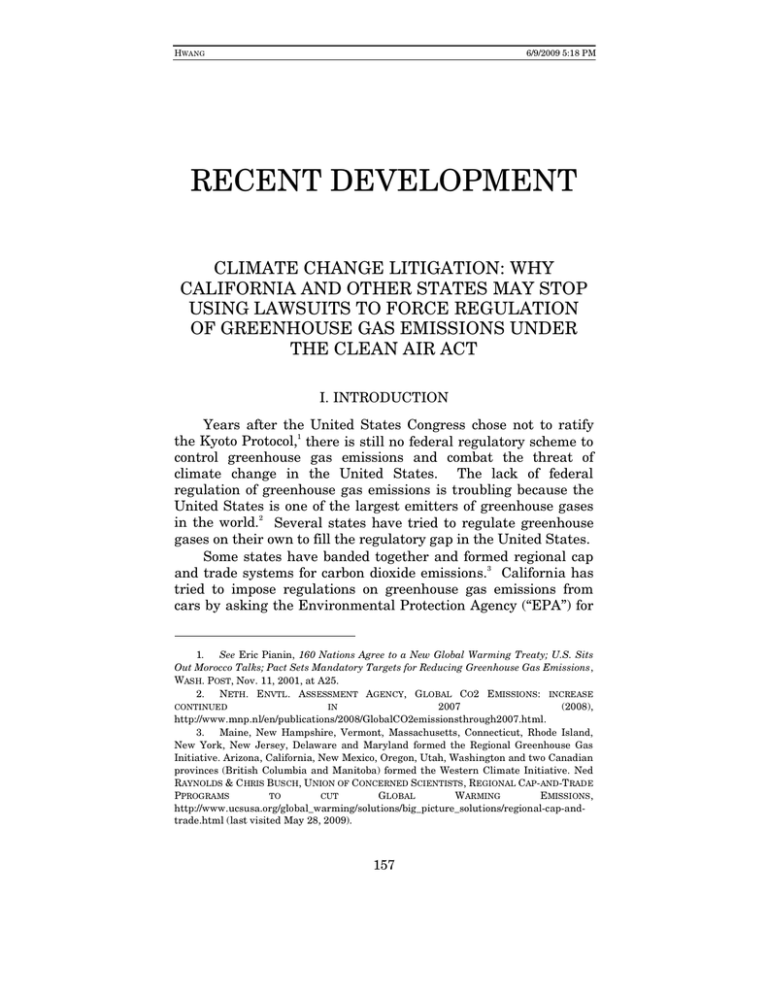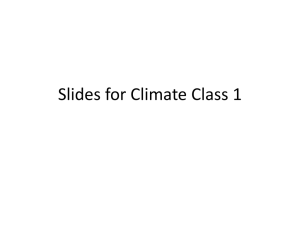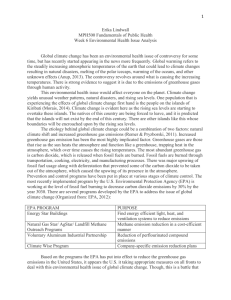RECENT DEVELOPMENT
advertisement

HWANG 6/9/2009 5:18 PM RECENT DEVELOPMENT CLIMATE CHANGE LITIGATION: WHY CALIFORNIA AND OTHER STATES MAY STOP USING LAWSUITS TO FORCE REGULATION OF GREENHOUSE GAS EMISSIONS UNDER THE CLEAN AIR ACT I. INTRODUCTION Years after the United States Congress chose not to ratify the Kyoto Protocol,1 there is still no federal regulatory scheme to control greenhouse gas emissions and combat the threat of climate change in the United States. The lack of federal regulation of greenhouse gas emissions is troubling because the United States is one of the largest emitters of greenhouse gases in the world.2 Several states have tried to regulate greenhouse gases on their own to fill the regulatory gap in the United States. Some states have banded together and formed regional cap 3 and trade systems for carbon dioxide emissions. California has tried to impose regulations on greenhouse gas emissions from cars by asking the Environmental Protection Agency (“EPA”) for 1. See Eric Pianin, 160 Nations Agree to a New Global Warming Treaty; U.S. Sits Out Morocco Talks; Pact Sets Mandatory Targets for Reducing Greenhouse Gas Emissions, WASH. POST, Nov. 11, 2001, at A25. 2. NETH. ENVTL . ASSESSMENT AGENCY, GLOBAL CO2 E MISSIONS: INCREASE 2007 (2008), CONTINUED IN http://www.mnp.nl/en/publications/2008/GlobalCO2emissionsthrough2007.html. 3. Maine, New Hampshire, Vermont, Massachusetts, Connecticut, Rhode Island, New York, New Jersey, Delaware and Maryland formed the Regional Greenhouse Gas Initiative. Arizona, California, New Mexico, Oregon, Utah, Washington and two Canadian provinces (British Columbia and Manitoba) formed the Western Climate Initiative. Ned RAYNOLDS & C HRIS BUSCH, UNION OF CONCERNED SCIENTISTS , REGIONAL CAP- AND-T RADE PPROGRAMS TO CUT GLOBAL WARMING EMISSIONS , http://www.ucsusa.org/global_warming/solutions/big_picture_solutions/regional-cap-andtrade.html (last visited May 28, 2009). 157 HWANG 158 6/9/2009 5:18 PM ENVIRONMENTAL & ENERGY LAW & POLICY J. [XX:N a waiver under the Clean Air Act (“CAA”).4 The EPA denied that waiver request.5 Using litigation, various states have also tried to force the federal government to regulate greenhouse gases under the CAA. The landmark case of such state-led litigation 6 efforts is Massachusetts v. Environmental Protection Agency. The Supreme Court held in Massachusetts that the EPA has the authority to regulate greenhouse gas emissions from 7 automobiles under the CAA, but the EPA has been slow to respond to the court decision.8 One year after Massachusetts, several states decided to initiate more litigation to force the EPA to regulate greenhouse gases. On July 31, 2008, several states and environmental groups notified the EPA that they intended to sue the agency for failing to regulate greenhouse gases from ships, aircraft, and off-road vehicles.9 This potential lawsuit is the focus of this article. Section II of the article lays out the factual background underlying the potential lawsuit. Section III analyzes the probability of the potential plaintiffs winning the lawsuit. Section IV explains why the potential plaintiffs may not actually file the lawsuit. II. BACKGROUND UNDERLYING THE POTENTIAL LAWSUIT On October 3, 2007, California and other government petitioners submitted a rulemaking petition to the EPA, pursuant to the Administrative Procedure Act, for regulation of greenhouse gas emissions from marine vessels.10 On November 4, 2007, the same petitioners filed a similar rulemaking petition 11 for regulation of greenhouse gas emissions from aircraft. The petitioners also filed a rulemaking petition for regulation of 4. See Juliet Eilperin, EPA Chief Denies Calif. Limit on Auto Emissions: Rules Would Target Greenhouse Gases, WASH. POST, Dec. 20, 2007, at A01. 5. Id. 6. Mass. v. Envtl. Prot. Agency, 549 U.S. 497, 528-29 (2007). 7. Id. 8. See Brad Knickerbocker, Bush’s ‘Caution’ on CO2 Seen as ‘Footdragging’ by Critics, CHRISTIAN SCI. MONITOR, Apr. 3, 2008, at 17. 9. Letter from Edmund G. Brown Jr., Attorney Gen., State of Cal., to Stephen Johnson, Adm’r, Envtl. Prot. Agency & Margo T. Oge, Dir., Office of Transp. & Air Quality, Envtl. Prot. Agency (July 31, 2008), available at http://ag.ca.gov/globalwarming/pdf/180_day_notice.pdf; Letter from Martin Wagner, Earthjustice, to Stephen Johnson, Adm’r, Envtl. Prot. Agency & Margo T. Oge, Dir., Office of Transp. & Air Quality, Envtl. Prot. Agency (July 31, 2008), available at http://www.earthjustice.org/library/legal_docs/notice-letter-08-07-28-final.pdf. 10. The other government petitioners joining California were Connecticut, New Jersey, Oregon, the Commonwealth of Pennsylvania Department of Environmental Protection and the City of New York. Letter from Edmund G. Brown Jr. to Stephen Johnson & Margo T. Oge, supra note 9, at 1. 11. Id. HWANG 200x] 6/9/2009 5:18 PM DESKTOP PUBLISHING EXAMPLE 159 greenhouse gas emissions from off-road vehicles on January 29, 2008.12 Earthjustice and other environmental groups submitted their petition for regulation of greenhouses gases from marine vessels on October 3, 2007.13 The environmental groups also filed a petition for regulation of greenhouse gases from aircraft on 14 December 31, 2007. The EPA had 180 days from the filing of the petitions to respond.15 The petitioners believed that the EPA failed to provide adequate responses to the petitions within the 180 day period, establishing a cause of action in their potential lawsuit against the EPA.16 On July 31, 2008, California, four other states, and three environmental groups informed the EPA of their intent to file a lawsuit against the agency.17 The four states joining California in submitting the notice were Connecticut, New Jersey, Oregon, and Pennsylvania18 The environmental groups participating in the notice were Friends of the Earth, the Center for Biological Diversity, and Oceana.19 In their notices, the potential plaintiffs claimed that the EPA unreasonably delayed the regulation of greenhouse gas emissions from ships, aircrafts, and off-road vehicles,20 and neither granted nor denied their rulemaking petitions.21 Furthermore, the EPA also failed to initiate a rulemaking process in response to the petitions; specifically, the EPA did not open a rulemaking 12. Id. 13. The other environmental groups joining Earthjustice were Oceana, Friends of the Earth and Center for Biological Diversity. Letter from Timothy Ballo & Sarah Burt, Earthjustice, to Stephen Johnson, Adm’r, Envtl. Prot. Agency (Oct. 3, 2007), available at http://www.earthjustice.org/library/legal_docs/ship-greenhouse-pollution-petition-toepa.pdf. 14. Letter from Alice R. Thomas, George M. Torgun & Martin Wagner, Earthjustice, to Stephen Johnson, Adm’r. Envtl. Prot. Agency (Dec. 31, 2007), available at http://www.earthjustice.org/library/legal_docs/petition-to-epa-on-aircraft-global-warmingemissions.pdf. 15. Letter from Edmund G. Brown Jr. to Stephen Johnson & Margo T. Oge, supra note 9; Letter from Martin Wagner to Stephen Johnson & Margo T. Oge, supra note 9. 16. See Letter from Edmund G. Brown Jr. to Stephen Johnson & Margo T. Oge, supra note 9; Letter from Martin Wagner to Stephen Johnson & Margo T. Oge, supra note 9. 17. Letter from Edmund G. Brown Jr. to Stephen Johnson & Margo T. Oge, supra note 9; Letter from Martin Wagner to Stephen Johnson & Margo T. Oge, supra note 9. 18. Letter from Edmund G. Brown Jr. to Stephen Johnson & Margo T. Oge, supra note 9, at 1. 19. Letter from Martin Wagner to Stephen Johnson & Margo T. Oge, supra note 9, at 1. 20. Letter from Edmund G. Brown Jr. to Stephen Johnson & Margo T. Oge, supra note 9, at 3; Letter from Martin Wagner to Stephen Johnson & Margo T. Oge, supra note 9, at 2. 21. Letter from Edmund G. Brown Jr. to Stephen Johnson & Margo T. Oge, supra note 9, at 2; Letter from Martin Wagner to Stephen Johnson & Margo T. Oge, supra note 9, at 2. HWANG 160 6/9/2009 5:18 PM ENVIRONMENTAL & ENERGY LAW & POLICY J. [XX:N docket.22 The EPA did issue an Advance Notice of Proposed Rulemaking (“ANPR”) for Regulating Greenhouse Gas Emissions 23 However, the under the Clean Air Act on July 11, 2008. petitioners in this case claimed the EPA did not make the required endangerment finding requested by the petitioners in the ANPR.24 The petitioners also believed that the ANPR did not actually begin the rulemaking process for regulation of greenhouse gas emissions from ships, aircraft, and off-road 25 According to the petitioners, by failing to find that vehicles. greenhouse gases endanger public welfare and health under the CAA and by not initiating a rulemaking process for regulation of such gases, the EPA is failing to meet its performance obligations under the CAA.26 Because of the EPA’s failure to regulate greenhouse gas emissions in a timely manner under the CAA, the petitioners believe they can compel agency action under Section 304(a)(3) of the CAA.27 However, before the petitioners can actually file a lawsuit to compel agency action for unreasonable delay, they need to give the EPA 180 days notice prior to taking legal action.28 The 180-day clock started ticking with the notice filed by California and its fellow petitioners on July 31, 2008. 29 III. THE LIKELY OUTCOME OF THE LAWSUIT AND EPA’S LIKELY 22. Letter from Edmund G. Brown Jr. to Stephen Johnson & Margo T. Oge, supra note 9, at 2; Letter from Martin Wagner to Stephen Johnson & Margo T. Oge, supra note 9, at 2. 23. Regulating Greenhouse Gas Emissions Under the Clean Air Act, 73 Fed. Reg. 44, 354 (proposed July 11, 2008) (to be codified at 40 C.F.R. ch. I). 24. Letter from Edmund G. Brown Jr. to Stephen Johnson & Margo T. Oge, supra note 9, at 2; Letter from Martin Wagner to Stephen Johnson & Margo T. Oge, supra note 9, at 3. 25. Letter from Edmund G. Brown Jr. to Stephen Johnson & Margo T. Oge, supra note 9, at 2; Letter from Martin Wagner to Stephen Johnson & Margo T. Oge, supra note 9, at 2. 26. Letter from Edmund G. Brown Jr. to Stephen Johnson & Margo T. Oge, supra note 9, at 3-4; Letter from Martin Wagner to Stephen Johnson & Margo T. Oge, supra note 9, at 3. 27. Letter from Edmund G. Brown Jr. to Stephen Johnson & Margo T. Oge, supra note 9, at 12; Letter from Martin Wagner to Stephen Johnson & Margo T. Oge, supra note 9, at 2. 28. Letter from Edmund G. Brown Jr. to Stephen Johnson & Margo T. Oge, supra note 9, at 3; Letter from Martin Wagner to Stephen Johnson & Margo T. Oge, supra note 9, at 2. 29. Letter from Edmund G. Brown Jr. to Stephen Johnson & Margo T. Oge, supra note 9, at 3; Letter from Martin Wagner to Stephen Johnson & Margo T. Oge, supra note 9, at 2. HWANG 200x] 6/9/2009 5:18 PM DESKTOP PUBLISHING EXAMPLE 161 RESPONSE TO THE OUTCOME The EPA will likely lose the potential lawsuit if the states and environmental groups actually file the lawsuit. The Supreme Court has already held in Massachusetts that the EPA has the regulatory authority to regulate greenhouse gases from cars 30 Once the EPA’s regulatory authority over under the CAA. greenhouse gases is established, the EPA has a legal obligation under the CAA to decide whether it wants to regulate such 31 emissions. The EPA’s regulatory authority also means the EPA has a legal obligation to respond to the rulemaking petitions of the potential plaintiffs. Under the CAA, the EPA cannot simply respond to petitioners’ rulemaking petitions with inaction.32 The EPA must respond to the rulemaking petition by either choosing to regulate greenhouse gas emissions from ships, aircraft, and off-road vehicles or choosing not to regulate such emissions. If the EPA has not responded at all to the petitions for rulemaking, as alleged by potential plaintiffs, a federal court will most likely rule against the EPA in the potential lawsuit. Assuming the EPA does lose the potential lawsuit in a federal court, and assuming the EPA chooses not to appeal that court decision, the EPA will be under significant legal pressure to respond to the petitioners’ rulemaking petitions. If the EPA responds to the rulemaking petitions negatively and chooses not to promulgate regulations for greenhouse gas emissions from ships, aircraft, and off-road vehicles, the EPA will have to provide reasons explaining why it decided to do so. This is unlikely as the EPA will have a difficult time explaining such a decision. Explaining its decision not to regulate will be difficult because EPA’s own staffers have already concluded that 33 greenhouse gas emissions endanger public health. Most likely, the EPA will respond to the rulemaking petitions affirmatively if they lose the potential lawsuit discussed above. The difficulty lies in how to regulate greenhouse gas emissions under the CAA. In fact, under the Bush administration, the EPA has already been grappling with the complexities and difficulties of 34 After the regulating greenhouse gases under the CAA. 30. Massachusetts, 549 U.S. at 528-29. 31. Id. 32. 42 U.S.C.S. § 7604(a) (LexisNexis 2008). 33. Juliet Eilperin, EPA E-Mail Concluded Global Warming Endangers Public Health, Senator Says, WASH. POST, July 25, 2008, at A19. 34. See, e.g., Regulating Greenhouse Gas Emissions Under the Clean Air Act, 73 Fed. Reg. at 44,354. HWANG 162 6/9/2009 5:18 PM ENVIRONMENTAL & ENERGY LAW & POLICY J. [XX:N Supreme Court decision in Massachusetts, EPA staffers began developing a framework for regulating greenhouse gases under the CAA. The result is the previously mentioned ANPR published by the EPA on July 11, 2008, a document over 500 35 pages long. Typically, an ANPR published by the EPA is merely a few pages long. Analyzing the difficulties and complexities of regulating greenhouse gas emissions under the CAA is beyond the scope of this article. For now, it is sufficient to state that regulating greenhouse gas emissions under the CAA is very complicated, as evidenced by the substantial length of the ANPR. IV. THE POTENTIAL PLAINTIFFS MAY NOT FILE THE THREATENED LAWSUIT AT ALL Because of the difficulties and complexities of actually regulating greenhouse gas emissions under the CAA, it is debatable whether the EPA should use the CAA as its primary 36 The CAA may even be a countertool for such regulations. productive tool for regulation of greenhouse gas emissions because Congress did not design the CAA’s regulatory framework for such a purpose.37 The potential plaintiffs in this case are probably aware of the difficulties of regulating greenhouse gas emissions under the CAA. They may no longer insist on regulating greenhouse gas emissions under the CAA if there are alternative federal regulatory schemes for regulating greenhouse gases. Under the Bush administration, which was reluctant to regulate greenhouse gas emissions at all,38 suing to regulate greenhouse gases under the CAA was one of the few available options for the potential plaintiffs to pursue. Ultimately, what the potential plaintiffs in this case probably want is an effective federal regulatory scheme to deal with the threat of climate change and curb greenhouse gas emissions. In the absence of an effective federal regulatory scheme for greenhouse gas emissions under the Bush administration, the plaintiffs’ threatened lawsuit and other similar lawsuits under the CAA are a part of a strategy to force 35. Id. 36. See Michael Northrop, Clean Air Jump-Start, ENVTL. FIN., Oct. 2008, at 19. 37. See Jonathan H. Adler, Warming Up to Climate Change Litigation, 93 V A. L. REV. IN BRIEF 63, 69-72 (2007), available at http://www.virginialawreview.org/inbrief/2007/05/21/adler.pdf. 38. Sheryl Gay Stolberg, Bush Proposes Goals on Greenhouse Gas Emissions, NYTIMES.COM, June 1, 2007, http://www.nytimes.com/2007/06/01/washington/01prexy.html. HWANG 200x] 6/9/2009 5:18 PM DESKTOP PUBLISHING EXAMPLE 163 some form of federal action on climate change. The plaintiffs may not have found it necessary to file the lawsuits, if the Bush administration had dealt with the climate change threat effectively and created alternatives to the CAA for climate change regulation. President Barack Obama stated his plan to push for such federal climate change regulations prior to being sworn in as 39 President. Since then, he has maintained his support for a federal climate change policy.40 The President’s regulatory agenda on climate change has the legislative support of the 41 Furthermore, under the Democratic majority in Congress. Obama administration, the EPA is now preparing to initiate regulation of greenhouse gas emissions under the CAA.42 Given the changing political landscape in Washington, D.C., and the increasing likelihood of future federal regulations for greenhouse gas emissions, the potential plaintiffs in this case may never file their threatened lawsuit. If the potential plaintiffs in this case expect President Obama to establish a federal climate change policy quickly, they probably will abandon or place a temporary hold on their current and planned lawsuits against the EPA for CAA greenhouse gas regulations. In fact, the potential plaintiffs have not yet initiated the threatened lawsuit, even though the 180-day notice period already passed.43 As long as the plaintiffs are confident that alternative and effective federal regulations will be in place to deal with the threat of climate change soon, they have no reason to file the threatened lawsuit against the EPA now. Jaw-Tyng Hwang 39. John M. Broder, Obama Affirms Climate Change Goals, NYTIMES.COM, Nov. 18, 2008, http://www.nytimes.com/2008/11/19/us/politics/19climate.html. 40. John M. Broder, Obama, Who Vowed Rapid Action on Climate Change, Turns More Cautious, N.Y. TIMES, Apr. 11, 2009, at A10. 41. See John M. Broder, Democrats Unveil Climate Bill, N.Y. TIMES, Apr. 1, 2009, at A19. 42. Juliet Eilperin, EPA Presses Obama to Regulate Warming Under Clean Air Act, WASH. POST, Mar. 24, 2009, at A01. 43. E-mail from Susan L. Durbin, Deputy Attorney Gen., Cal. Dep’t of Justice, to author (Apr. 15, 2009) (on file with author); E-mail from Martin Wagner, Attorney, Earthjustice, to author (Apr. 15, 2009) (on file with author).







